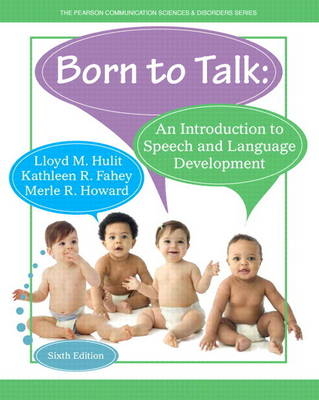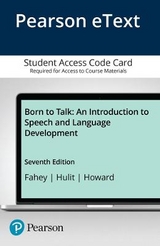
Born to Talk
Pearson (Hersteller)
978-0-13-358525-4 (ISBN)
- Titel erscheint in neuer Auflage
- Artikel merken
If purchasing or renting from companies other than Pearson, the access codes for the Enhanced Pearson eText may not be included, may be incorrect, or may be previously redeemed. Check with the seller before completing your purchase.
This access code card provides access to the Enhanced Pearson eText
With its primary focus on language development, Born to Talk, 6/e provides a comprehensive, contemporary, reader-friendly look at the many new and exciting contributions to the information about human language acquisition. In it, readers keep informed of the complex array of topics that provide the foundation for human communication and its development from birth through young adulthood. It is the ideal resource for students and practitioners in speech-language pathology, early childhood education, general education, special education, and related disciplines. The Enhanced Pearson eText features embedded video to illustrate key concepts and pop-up assessments to help students assess their proficiency.
Improve mastery and retention with the Enhanced Pearson eText*
This access code card provides access to the new Enhanced Pearson eText, a rich, interactive learning environment designed to improve student mastery of content. The Enhanced Pearson eText is:
Engaging. The new interactive, multimedia learning features were developed by the authors and other subject-matter experts to deepen and enrich the learning experience.
Convenient. Enjoy instant online access from your computer or download the Pearson eText App to read on or offline on your iPad® and Android® tablet.*
Affordable. Experience the advantages of the Enhanced Pearson eText for 40-65% less than a print bound book.
*The Enhanced eText features are only available in the Pearson eText format. They are not available in third-party eTexts or downloads.
*The Pearson eText App is available on Google Play and in the App Store. It requires Android OS 3.1-4, a 7” or 10” tablet, or iPad iOS 5.0 or later.
Kathleen Fahey, Ph.D. is Professor Emeritus at the University of Northern Colorado. She is a speech-language pathologist with 36 years experience in the assessment and intervention of childhood speech, language and literacy disorders. Her areas of expertise include development and disorders of articulation and phonology, early language, and school-age language and literacy. She teaches undergraduate and graduate courses in a traditional and online format.
Preface
Chapter 1
A Connection of Brains
Separate but Related Processes
The Unique Characteristics of Human Speech
Speech: The Tale of Two Brains
Surfing the Web
Review Questions
Chapter 2
Language Acquisition: A Theoretical Journey
Evidence of Biological and Environmental Influences on Language Learning
A Review: The Major Theories of Language Acquisition
Surfing the Web
Review Questions
Chapter 3
Cognitive Development: Building a Foundation for Language
Piaget’s Theory of Cognitive Development
Vygotsky’s Theory of Cognitive Development: A Sociocultural Perspective
Dynamic Systems Theory
The Perceptual Groundwork for Communication
Executive Functions
Surfing the Web
Review Questions
Chapter 4
In the Beginning: Communication Development from Birth to 2 Years
From the Beginning, the Infant Communicates
Ready to Receive Language: Perception and Comprehension of Words
Ready to Speak: Expressive Growth in Infancy
The Development of Communication Functions: Using Communication to Get Things Done
Beyond Infancy: The Emergence of Language
Early Syntactic Development: A Stage Model
Early Stage 1 (MLU: 1.0 to 1.5; Age: 12 to 22 Months)
Late Stage 1: Syntactic Development–Words to Word Combinations (MLU: 1.5 to 2.0; Age: 22 to 26 Months)
Comprehension and Production: A Critical and Evolving Relationship
Social Routines Involving Literacy: Songs, Rhymes, and Stories
Stage 1: A Brief Look Back and a Glimpse Forward
Surfing the Web
Review Questions
Chapter 5
The Saga Continues: Language Development Through the Preschool Years
Stage 2: Elaborating Structure and Refining Meaning
Stage 3: Producing Longer, More Adultlike Sentences
Stage 4: Elaboration with Phrases and Clauses
Stage 5: Polishing the Act
The Role of Comprehension and Production in Language Development
Surfing the Web
Review Questions
Chapter 6
Taking Language to School and into Adulthood
The Classroom and Language: New Demands
Semantic Development
Syntax and Morphology
Pragmatics, Conversation, and Narratives
Metalinguistic Development During the School Years
Learning to Read and Write
And the Beat Goes On . . .
Surfing the Web
Review Questions
Chapter 7
The Building Blocks of Speech
Describing Speech Sounds
Development of Speech Sounds in Prelinguistic and The One-Word Stage
Development of Speech Sounds in Two-Word Utterances and Beyond
Coarticulation and Suprasegmental Aspects of Speech Production
The Roles of Biology, Cognition, and Social Interaction in Phonological Development
Surfing the Web
Review Questions
Chapter 8
Language Diversity: Social/Cultural and Regional Differences
Socioeconomic Factors
Social/Cultural Factors
Social/Cultural Dialects
The Changing Face of America and Bilingual Language Development
Bilingualism
The Optimal Age of Second Language Learning
Cognition, Language, and Literacy Development
Cultural Diversity in the Public Schools
Surfing the Web
Review Questions
Chapter 9
Speech and Language Disorders in the Home, School, and Community
Interrelationships of Speech and Language Disorders
Causes and Types of Communication Disorders
Speech Disorders
Summary
Final Thoughts
Surfing the Web
Review Questions
Appendix
The Anatomical and Physiological Bases of Speech, Language, and Hearing
Speech as the Product of Borrowed Structures
The Four Processes of Speech
Respiration
Phonation
Resonation
Articulation
The Four Processes in Review
The Brain: The Computer Center for Speech and Language
The Ear: An Energy Transformer
The Complete Speech and Language Machine
Surfing the Web
Review Questions
Glossary
Name Index
Subject Index
References and Suggested Readings
| Erscheint lt. Verlag | 6.8.2014 |
|---|---|
| Sprache | englisch |
| Maße | 205 x 255 mm |
| Gewicht | 580 g |
| Themenwelt | Geisteswissenschaften ► Sprach- / Literaturwissenschaft ► Sprachwissenschaft |
| Medizin / Pharmazie ► Gesundheitsfachberufe ► Logopädie | |
| ISBN-10 | 0-13-358525-5 / 0133585255 |
| ISBN-13 | 978-0-13-358525-4 / 9780133585254 |
| Zustand | Neuware |
| Haben Sie eine Frage zum Produkt? |
aus dem Bereich

